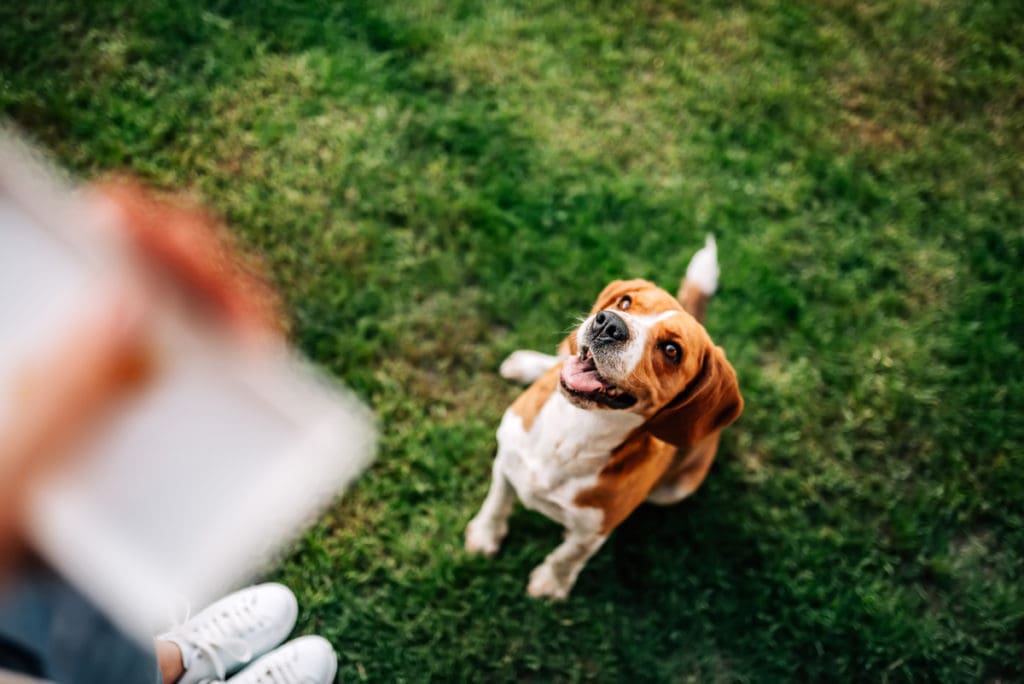Tips for successfully teaching your dog
At Dogs for Good, we know a little bit about training and teaching dogs. In the 30+ years that we’ve been doing it, we’ve seen methods come and go but our preferred way of doing things has never changed. We teach our amazing assistance dogs everything we ask of them in a really positive, kind and ethical way. That way, they understand, trust and go on to be confident dogs that are able to form healthy relationships with humans.
We teach our dogs using ‘positive reinforcement training’ methods. It’s a bit of a mouthful but at its heart, it means positively pairing the moment your dog makes a good choice with a reward, so they’re likely to want to behave that way again. This could be anything that your dog finds rewarding such as food, toys, fuss and encouragement. Whatever your dog responds to best.

Our belief if that if you get it right for your dog and understand their needs, you’ll get it right for you, too.
Before you start teaching your dog, there are some important things to consider:
Build a bond with your dog
Never underestimate the importance of your relationship with your dog. Make sure you spend lots of time with playing and interacting with them every day so they build a mental history of doing fun and rewarding things with you. You’ll also then get a chance to see their different reactions to things, such as enjoyment, confusion and frustration.
Bonding with a rescue dog
If you have welcomed an older and/or rescue dog into your life, you can start to build your bond with them with lots of positive reward.
Keep things simple to begin with by helping them to understand what their normal routine will look like; your dog will be picking up on all sorts of things you do and regular routines will help them to settle and reduce anxiety. Your friends may be excited to meet your dog but it’s better to keep introductions gradual and low level so your dog doesn’t think that every day is like Christmas!
Have realistic expectations
Spending a little bit of time thinking about what might be realistic for you and your dog will help to strengthen your relationship and manage expectations. For example, if you’ve rehomed an older dog who has spent the last year happily sitting on the sofa, immediately expecting him or her to accompany you on long walks through the countryside is not realistic.
Equally, if your dog has a sensitivity around energetic children, it’s not realistic to expect them to enjoy a walk near playgrounds. Gradually working up towards longer walks or going to places with a few children is something you can work on but it takes time, patience and a willingness to accept that if your dog remains reluctant, it’s kinder to stop asking.
So, don’t worry about teaching your dog lots of tricks if they’re it’s not actually that important. Try not to get cross when they occasionally pull on the lead; be happy that they walk along nicely most of the time. Be happy with what they can do because by doing so, your bond will be stronger.
Training your dog
The most important part of any dog training session is that you build a happy, positive relationship with your dog. The benefits go far deeper than just the training side of it, because spending time together will help you and your dog understand each other better.
One step at a time
Break everything down into little steps.
For example, if you want your dog to walk next to you on a loose lead start off by doing some off-lead work. Our trainers generally start by walking the dog in our training hall and every time the dog reaches the side of their leg, they’ll immediately mark that with a vocal cue such as ‘good’ or ‘yes’ using a positive voice and then a piece of kibble from their allowance. Once that’s starting to come good, they’ll take the dog outside into a secure area and start working on it in the outdoor environment, still using the food reward and vocal confirmation. From there, they’ll start working on-lead and keep breaking the training down into small parts.
In a domestic setting, this could be started inside the home, progressing to the garden, taking it outside onto the driveway or down a short alleyway… you get the gist.
Patience is key
Make sure you’re always teaching your dog as an individual and pitch everything at the right level for them.
Be patient, prepared and look to yourself for errors in your approach rather than assuming your dog isn’t getting it.
Don’t spend too long training anything. An adult dog can only cope with 10 minutes at a time before it needs a break and a puppy will lose concentration far more quickly than that!
Get some Zzzs
Remember that dogs process a great deal when they’re asleep. So, if you’ve spent 10 minutes teaching your dog something and you feel that despite your best efforts, they’re just not getting it, let them sleep on it. They may surprise you the next day!
Start young but slowly
Positive reinforcement training can start from a very early age. So, if you get your dog as a puppy, remember that as soon he or she leaves their mum, you can start to teach them about all the world. Don’t rush it and introduce them to experiencing new things and environments slowly and positively.
Keep encouraging the behaviour you like with vocal praise, fuss or maybe a food reward. Start with things like their new collar, new lead, new bed, the car and then think about short positive visits out.
Good socialisation is the cornerstone of a confident dog that’s receptive to being taught lots of new things as he or she gets older. We’re so fortunate to have a band of volunteer puppy socialisers that do sterling work making sure our pups have the best start in life and are socialised to be confident, happy dogs familiar with a whole host of different environments.
Time spent teaching your dog can be a great way to build your bond; ten minutes teaching them something is the equivalent of a 30-minute walk in terms of engaging your dog’s brain. Our assistance dogs in training certainly enjoy everything they’re learning if the amount of tail wagging is anything to go by!
Get some good professional help
If you’re going to seek professional help from a dog trainer or training classes, it’s important that you get on or ‘gel’ with the person running them. It’s a good idea to ask to attend a class as an observer first – without your dog – so that you can get a feel for how they do things. If you go and see a huge amount of stressed dogs in a room or they don’t train using methods you’re willing to use with your dog, it’s probably best to politely leave.
Distractions & Environment
Be aware of distractions which will divert your dog’s attention away from you.
For example, you don’t learn to drive on the motorway. You start off on quiet side roads and learn slowly, processing all the new things you’re learning without distractions which are overwhelming. It’s the same for dogs, so be aware of your environment and take things slowly until you’re confident that they’ve really got what you’re asking before you move on to the next lesson.
Also, think about expectations. For example, if your dog is responding nicely indoors, you may have to go back a couple of steps if you take the same thing outdoors into the garden or on a walk.
Small steps are the key to success when teaching your dog and in the beginning, being as consistent as possible will help your dog to better understand what you’re asking of him or her. Then, when you feel that your dog is confidently understanding you, you could try ‘checking’ the request by changing the room you use or sitting yourself down on the floor rather than standing up to issue the cue. If it doesn’t work, go back a step or two and start again.
Help support our life-changing work...
Imagine if everyday tasks were so challenging or physically demanding they affected your quality of life. For many people living with a disability of families with a child with autism, that is their reality. Now imagine if a specially trained four-legged friend could restore your, or your family’s, independence.
The demand for our services is high and we can’t help as many people as we would like to without more funding. Please help us continue to bring people and dogs together to help make everyday life possible in so many extraordinary ways.
Every contribution, whatever size, is important and helps us make a difference.

